Sales by Email: Outreach Strategies and Best Practices
Casey O'Connor
Small and medium businesses (SMBs) have unique challenges when it comes to building a healthy sales pipeline.
While email is generally the most efficient way for SMBs to reach their lead lists, it can be challenging for marketing and sales teams to balance large-scale outreach with the high level of personalization that today’s B2B buyer expects.
There are, of course, email software solutions that can help sales teams succeed with sales by email. That being said, many of them are massive platforms (that come with similarly massive price tags) that are typically too bulky and complex for SMBs.
While sales emails don’t close deals, they are a crucial first step in booking sales calls, meetings, and demos. Small business sales teams need cost-effective and streamlined email outreach solutions that can help them write, send, and track emails that buyers are eager to open and that help them move down the sales funnel.
In this article, we’ll go over everything you need to know about sales by email, including why it’s so important for SMBs, how to write emails that build trust and nurture buyers, best practices to keep in mind, and some features to look for as you’re looking for platforms to support your sales email strategies.
Here’s what we’ll cover:
- Understanding the Power of Email in Sales
- Crafting Effective Email Outreach Campaigns
- Overcoming Common Challenges in Email Sales
- Tips for Optimizing Email Sales Strategies
- Compliance and Best Practices
- Key Features to Look for in Email Outreach Solutions
Understanding the Power of Email in Sales
Email is one of the most versatile and effective forms of communication available to sales teams today.
With the right tools and strategies, sales teams can use email to reach large numbers of prospects and customers at scale, all while maintaining the kind of email personalization and customized experience that buyers expect. 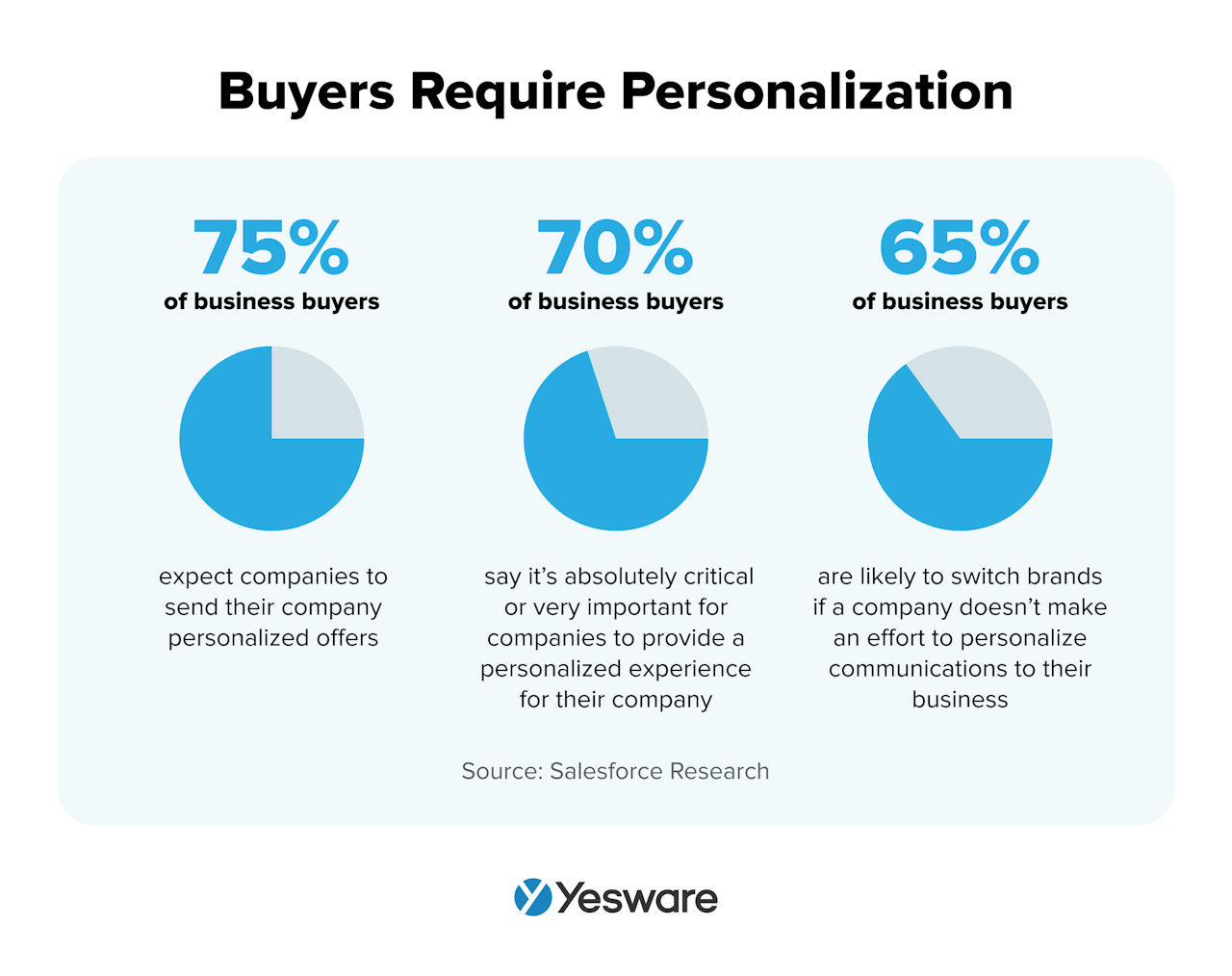 And this isn’t just buyer preference; email personalization has a significant impact on several email performance metrics, including open rate, click-through rate (CTR), returning site traffic, conversion rates, and more.
And this isn’t just buyer preference; email personalization has a significant impact on several email performance metrics, including open rate, click-through rate (CTR), returning site traffic, conversion rates, and more.
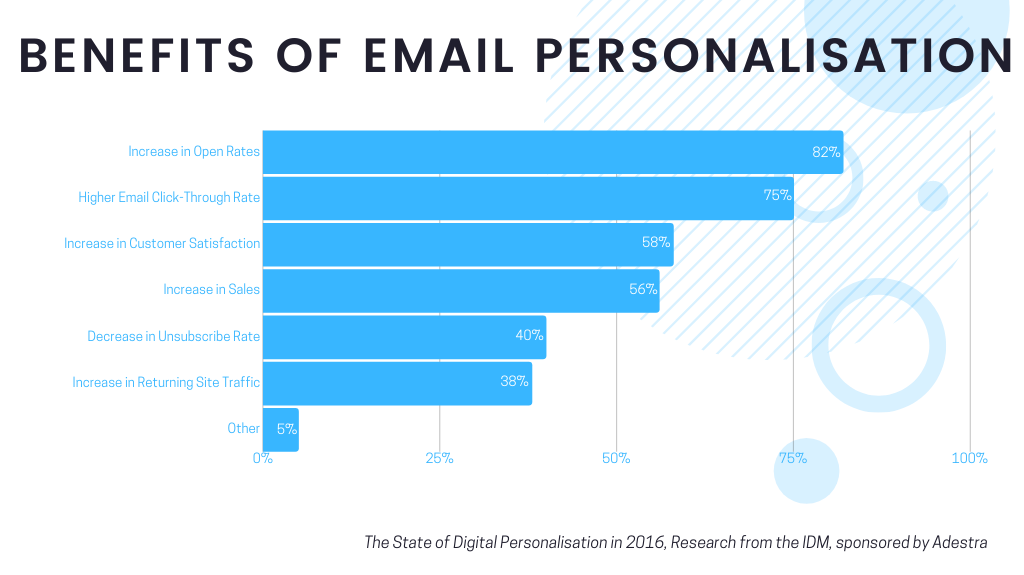
The return on investment for sales by email is impressively lucrative. In fact, some studies show that the ROI for sales emails is $38 for every $1 spent.
That all being said, writing sales emails that stand out isn’t necessarily straightforward or easy. The average office worker receives over 120 emails per day, and 64% of them decide whether to open or delete their messages based on a single glance at the subject line.
Writing email campaigns that stand out in a busy inbox, are intriguing enough to get opened, and engaging enough to prompt the recipient to take action requires skill and strategy. But for sales teams that master it, sales by email can be a game-changer.
Crafting Effective Email Outreach Campaigns
The key to success in sales by email is personalization.
Each and every component of your sales emails needs to be tailored to the target audience.
In order to achieve this level of personalization, sales reps need to have a deep understanding of both their ideal customer profile (ICP) and the specific buyer personas they may encounter when sending a sales email. 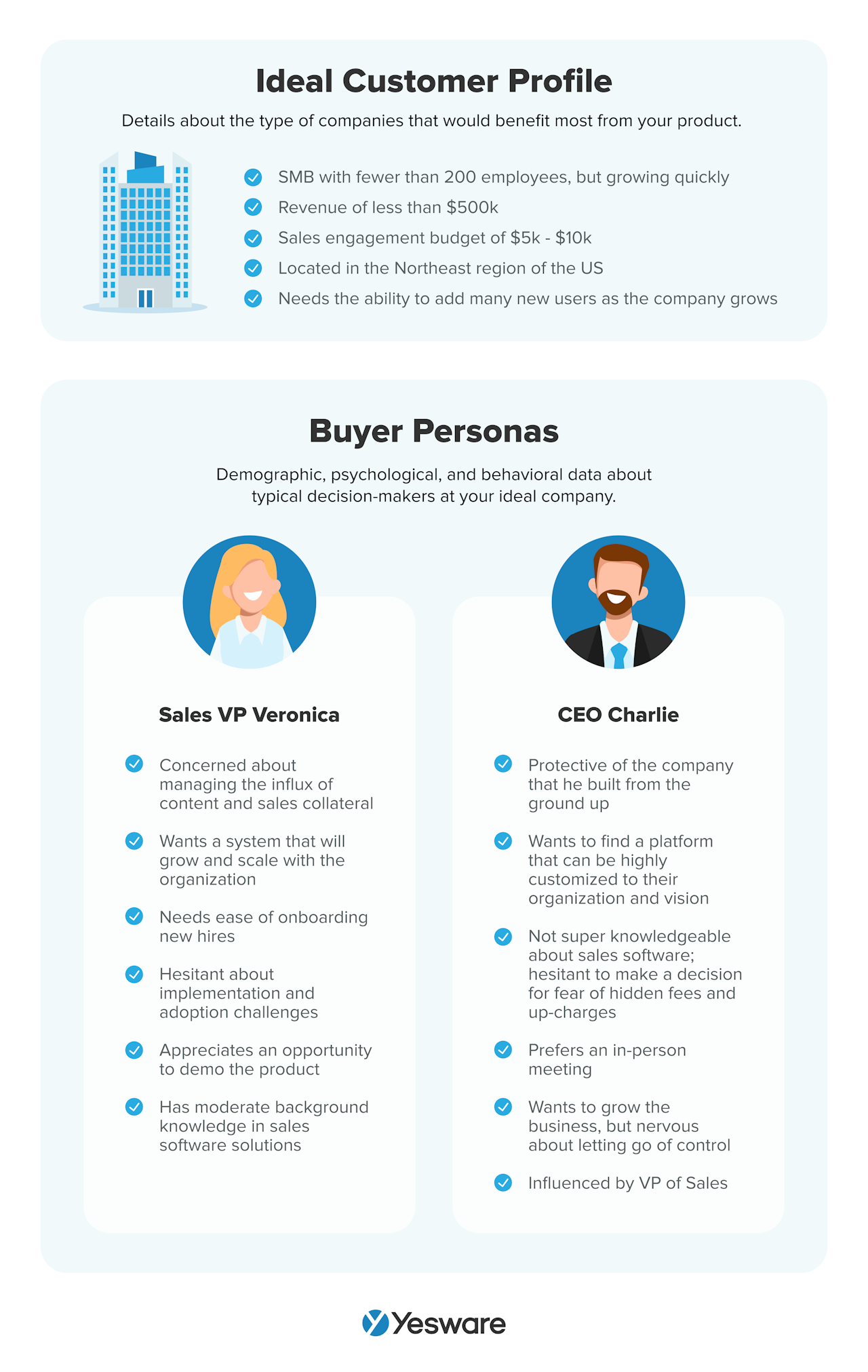 All of your email messages need to speak specifically to each individual recipient’s unique needs and preferences — even when they’re dispatched as part of a larger campaign.
All of your email messages need to speak specifically to each individual recipient’s unique needs and preferences — even when they’re dispatched as part of a larger campaign.
Fortunately, with the help of the right kind of email outreach platform, there are several “built-in” opportunities for personalization within a sales email.
Email Subject Line
Your email’s subject line is its first impression.
The subject line is the very first thing the recipient notices about your email message. And knowing how ruthless email recipients are when it comes to purging their inboxes — about 80% – 90% of all emails are deleted without ever being opened — so it’s important to get the subject line right.
Your subject line should be short (36-50 characters), engaging, and personalized.
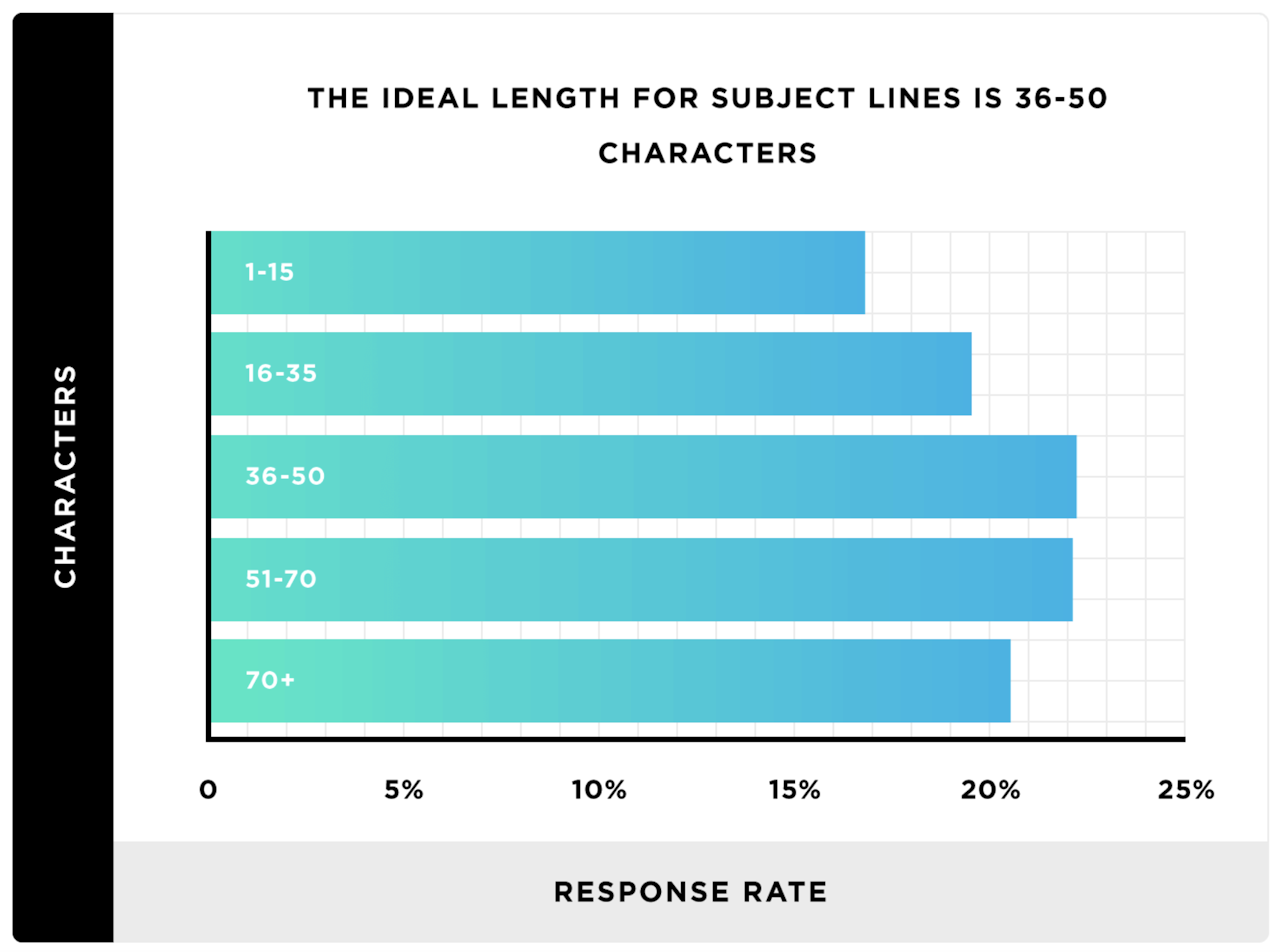
Many sales reps swear by using the recipient’s name in the subject line, while others prefer to allude to one of their specific pain points.
Other successful subject lines include relevant data, or an insightful, thought-provoking question.
Whatever you do, though, stay away from clickbait-type headlines, all-capital-letter subject lines, and words that could send you to the spam folder (e.g., “final,” “sale,” “tempting”). Emojis should also be used sparingly, if at all.
It’s also important to ensure that your entire subject line is visible on both desktop and mobile.
To that end, preheader text (the text that follows the subject line) is also visible on mobile and some desktop views, so be intentional about this component of your sales emails, as well. 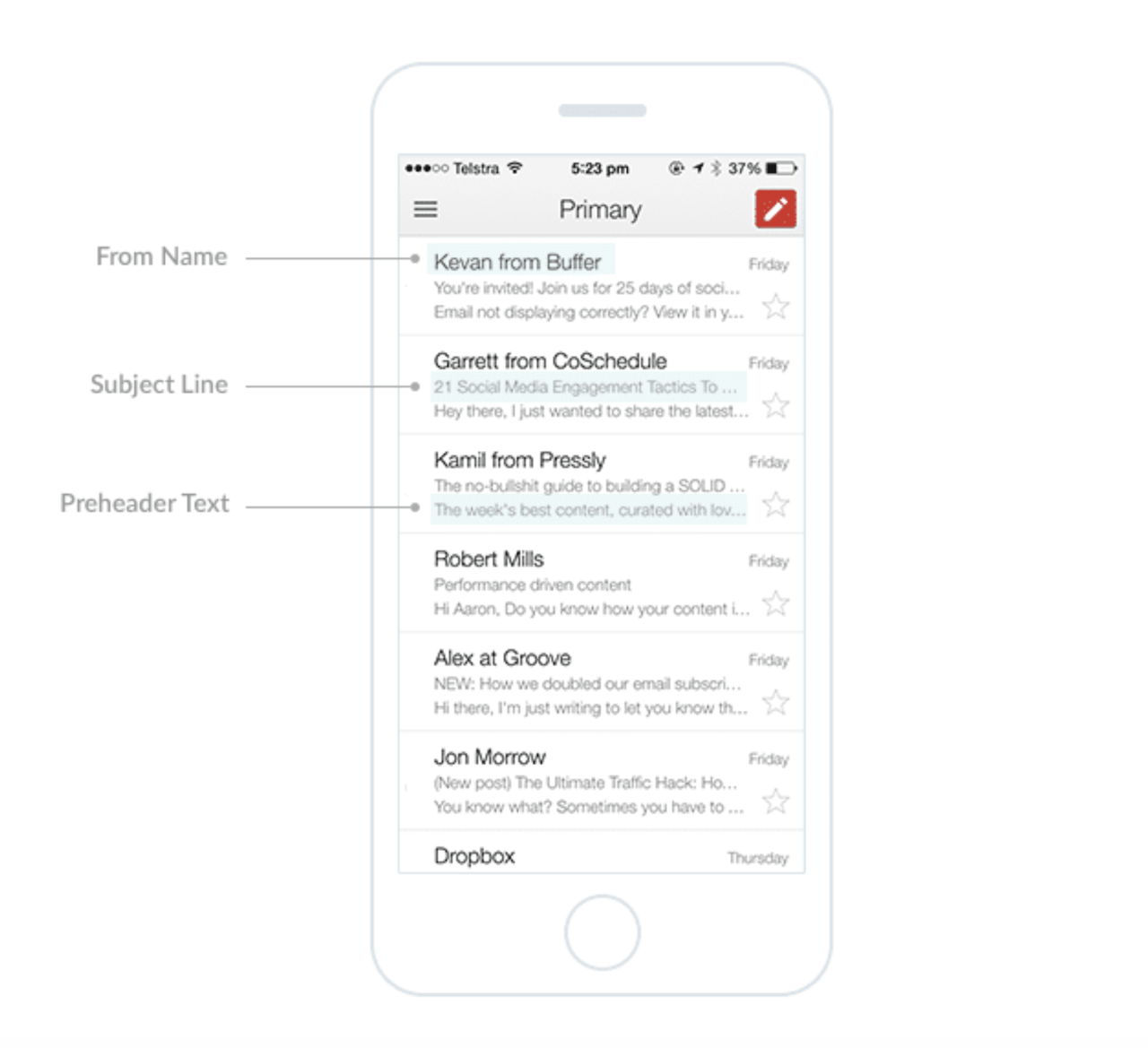
Successful open rates will vary by industry, but most fall in the 30% – 50% range.
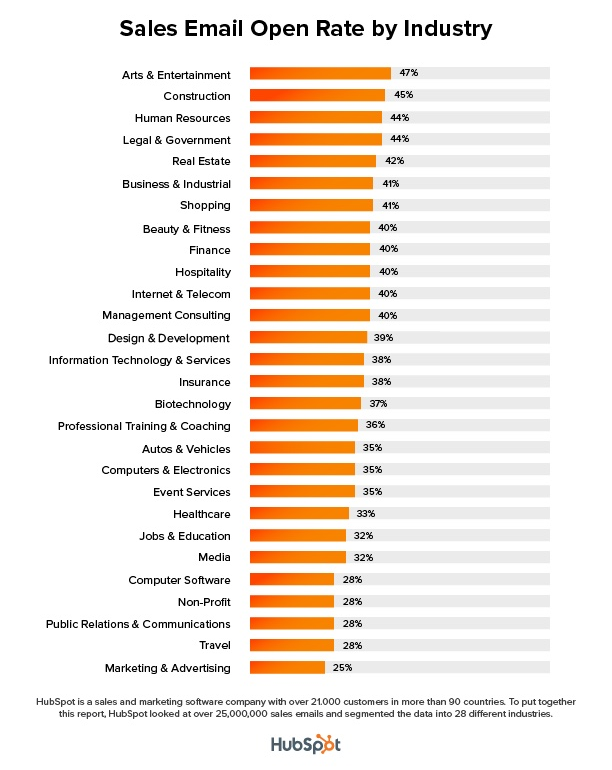
Sales teams should consider A/B testing their subject lines (more on this strategy later) to determine their most successful options.
Tip: 20 Cold Email Subject Lines (proven to get over 85% open rates.)
Opening Line
The opening line of your email is also very important. It’s one thing to get over the hurdle of convincing the recipient to open the email, but it’s another challenge entirely to get them to keep reading.
The first line of your email exists to pique the reader’s interest. It needs to be non-generic and enticing in order to encourage them to keep reading.
Here are some common strategies for writing an opening line that gets attention:
- Use the recipient’s name or the name of a mutual connection (i.e., “Mark recommended I get in touch.”)
- Directly address a challenge or pain point
- Acknowledge a new role or achievement
- Reference a news article or other publication
Remember, this component of your sales email needs to be personalized. Segmenting your outreach lists can create better opportunities for more specific and targeted email personalization.
Tip: Go into any sales conversation, whether that be via email or phone, with a custom sentence that will immediately build rapport with the recipient. 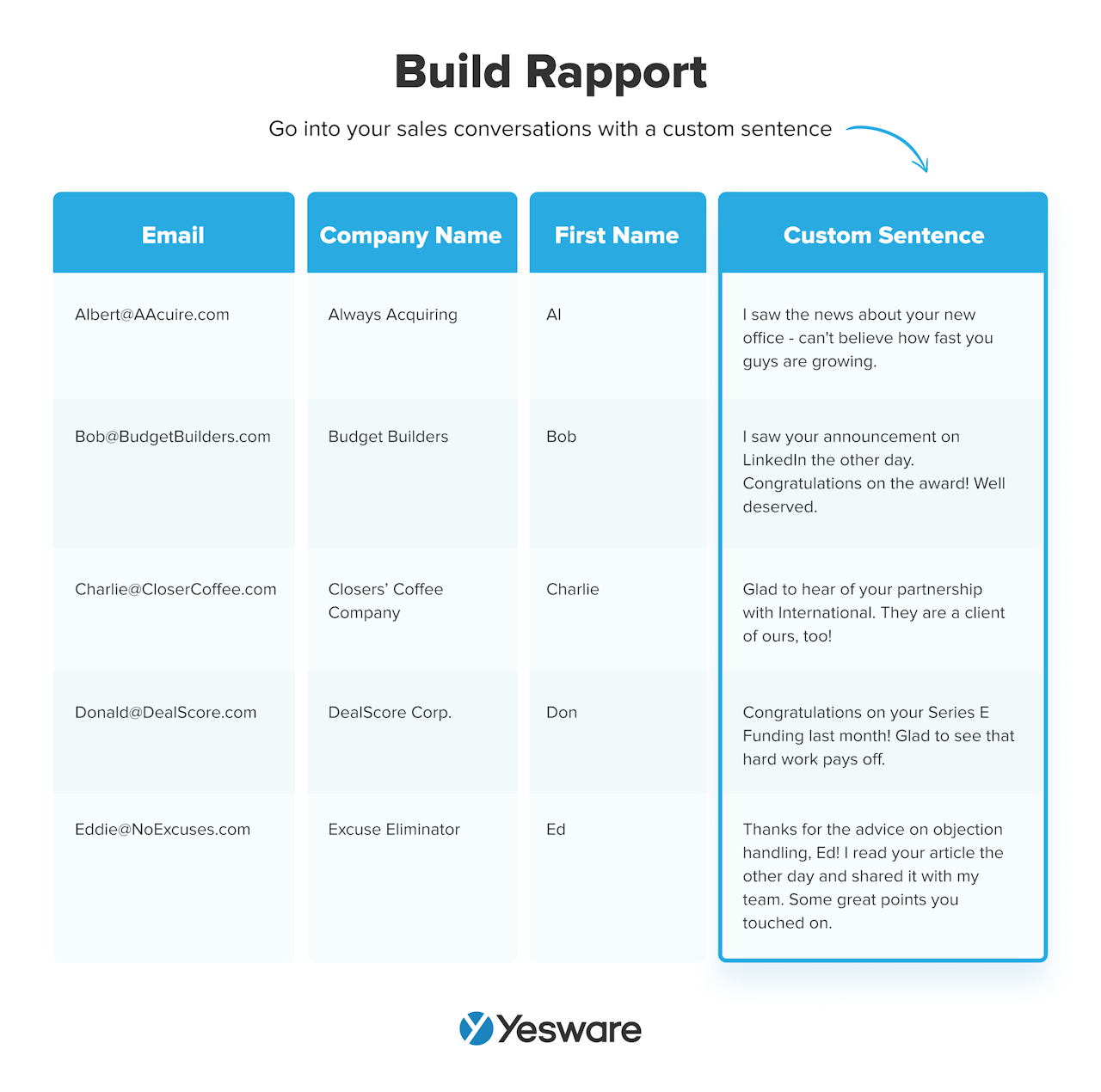
Body Copy
The body copy of the sales email contains most of the substance of the email message. Here, sales reps can demonstrate value, generate trust, and (hopefully) move the sales process forward.
Again, it’s important to avoid anything that can be construed as generic. Use this space to ask questions that are specific to the prospective company based on your research and focus on providing value.
Social proof can go a long way in this part of the email, depending on the circumstances of the campaign and the recipient’s needs and preferences. 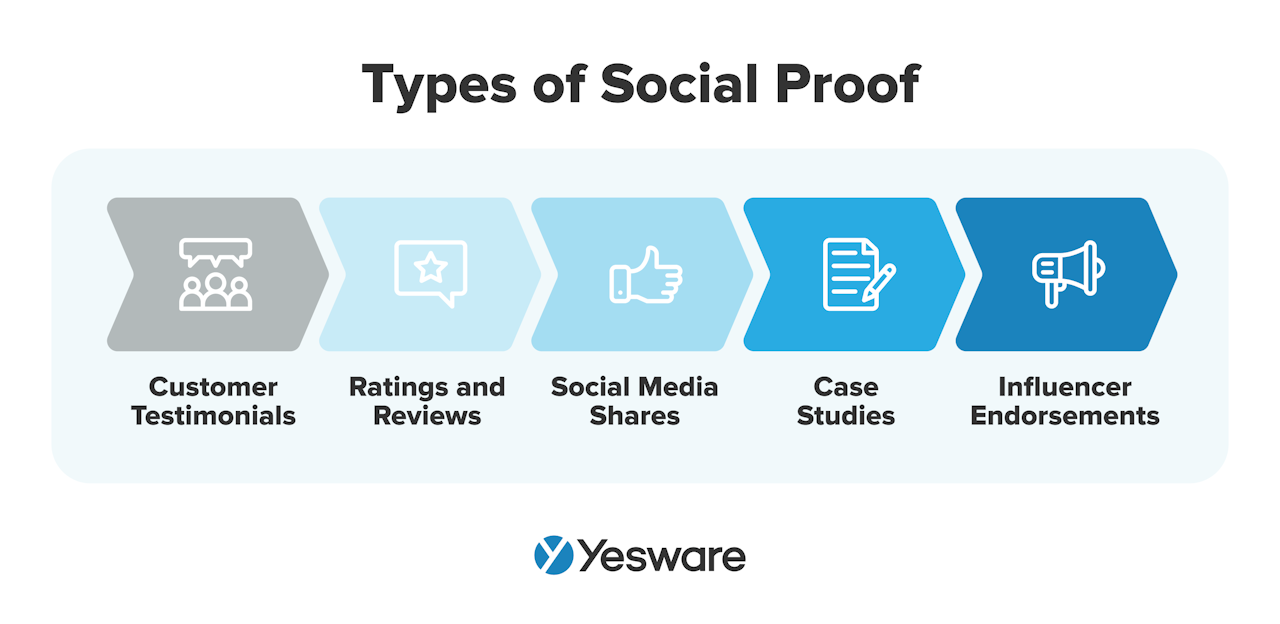 Whatever you do, avoid talking too much about yourself or even too much about your product. Be direct and respectful of the recipient’s time, and show that it’s worth it to continue a conversation with you.
Whatever you do, avoid talking too much about yourself or even too much about your product. Be direct and respectful of the recipient’s time, and show that it’s worth it to continue a conversation with you.
Closing
Many sales reps are great at closing deals in person, but sales by email require a slightly different set of skills.
The closing of your email is also sometimes called the call to action (CTA) and is designed to encourage readers to take the next action in the sales funnel.
A great CTA should guide the buyer directly to the next step with as little friction as possible. 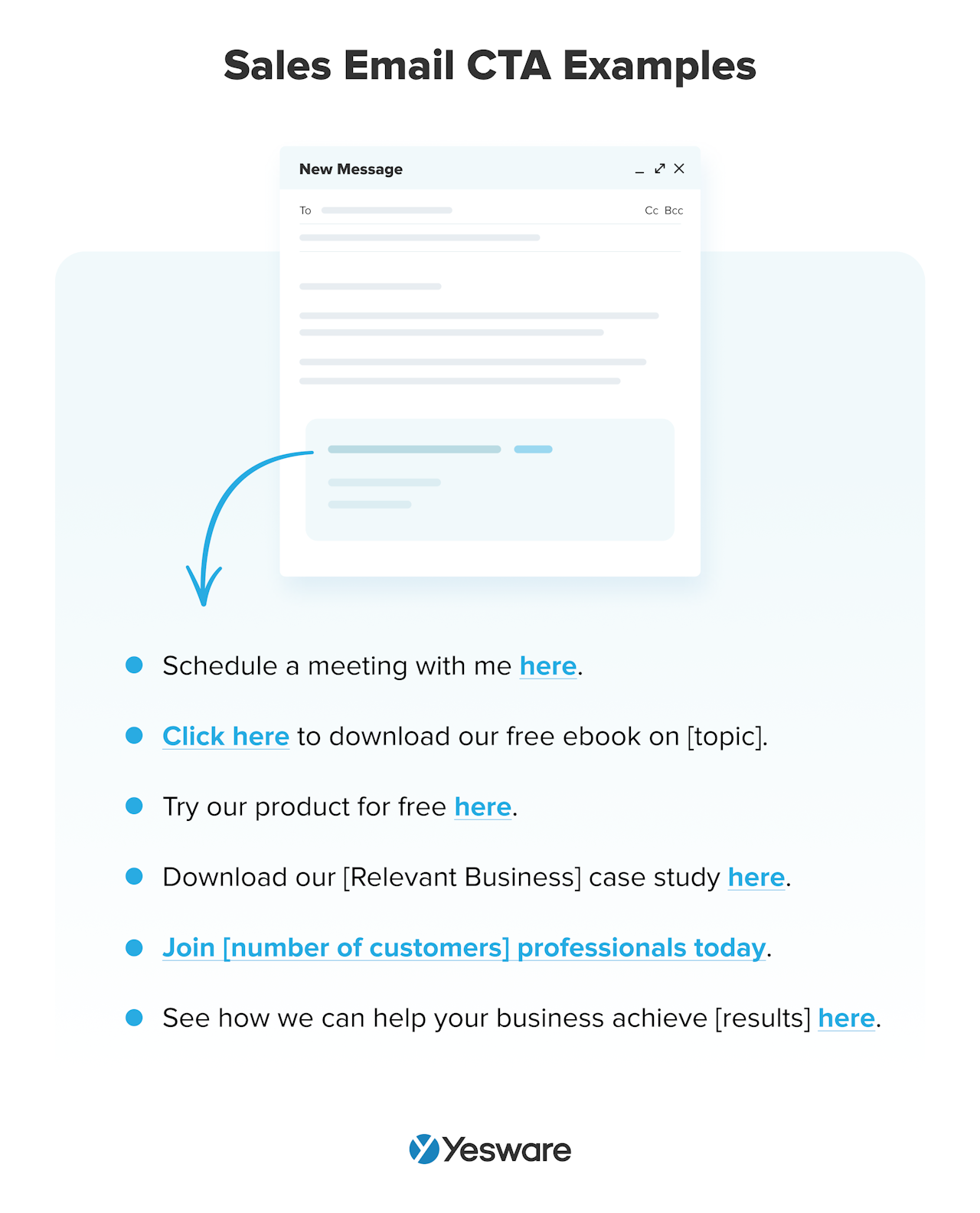 For decades, the guidance on CTAs has been to make them as definitive as possible (i.e., “Let’s set up a time to talk — Tuesday at 2pm?”).
For decades, the guidance on CTAs has been to make them as definitive as possible (i.e., “Let’s set up a time to talk — Tuesday at 2pm?”).
But recently, there’s been a shift in sales emails that highlights “softer” CTAs — ones that ask about interest level, rather than direct next steps (i.e., “How would you feel about speaking further on Monday afternoon?”).
Buyers today are eager to maintain more control over the buying process, so putting the ball in their court may make them more inclined to move forward. This is another component of your sales email performance that could benefit from A/B testing.
Email Signature
Some salespeople give little thought to their email signature, but this part shouldn’t just be an afterthought. A formal email signature can add professionalism and credibility to your message.
Keep your signature short, simple, and on brand. It should include the following information:
- First and last name
- Role & Company
- Phone numbers
- Links to social media profiles of your choice
And, just like with all of the other components of your message, always make sure your signature is formatted for mobile as well as desktop.
Here’s a solid example:

Overcoming Common Challenges in Email Sales
Although sales by email can be a powerful tool for sales teams, there are some challenges to keep in mind as you add or refine this strategy in your sales playbook.
Email Deliverability and Spam
One of the most common issues that sales reps encounter when selling by email is the risk of their messages ending up in the spam folder.
Sales teams need to make sure that they’re carefully tracking their email deliverability and be prepared to be critical about any components that may be affecting this metric.
Different email service providers (ESPs) have different standards when it comes to spam filters and deliverability requirements, so make sure that the email automation platform you use is able to comply with these regulations across the board.
Deliverability factors can get complex in a hurry, with action items like authenticating your email domain and maintaining proper IP allocation that many sales reps may not know how to complete. 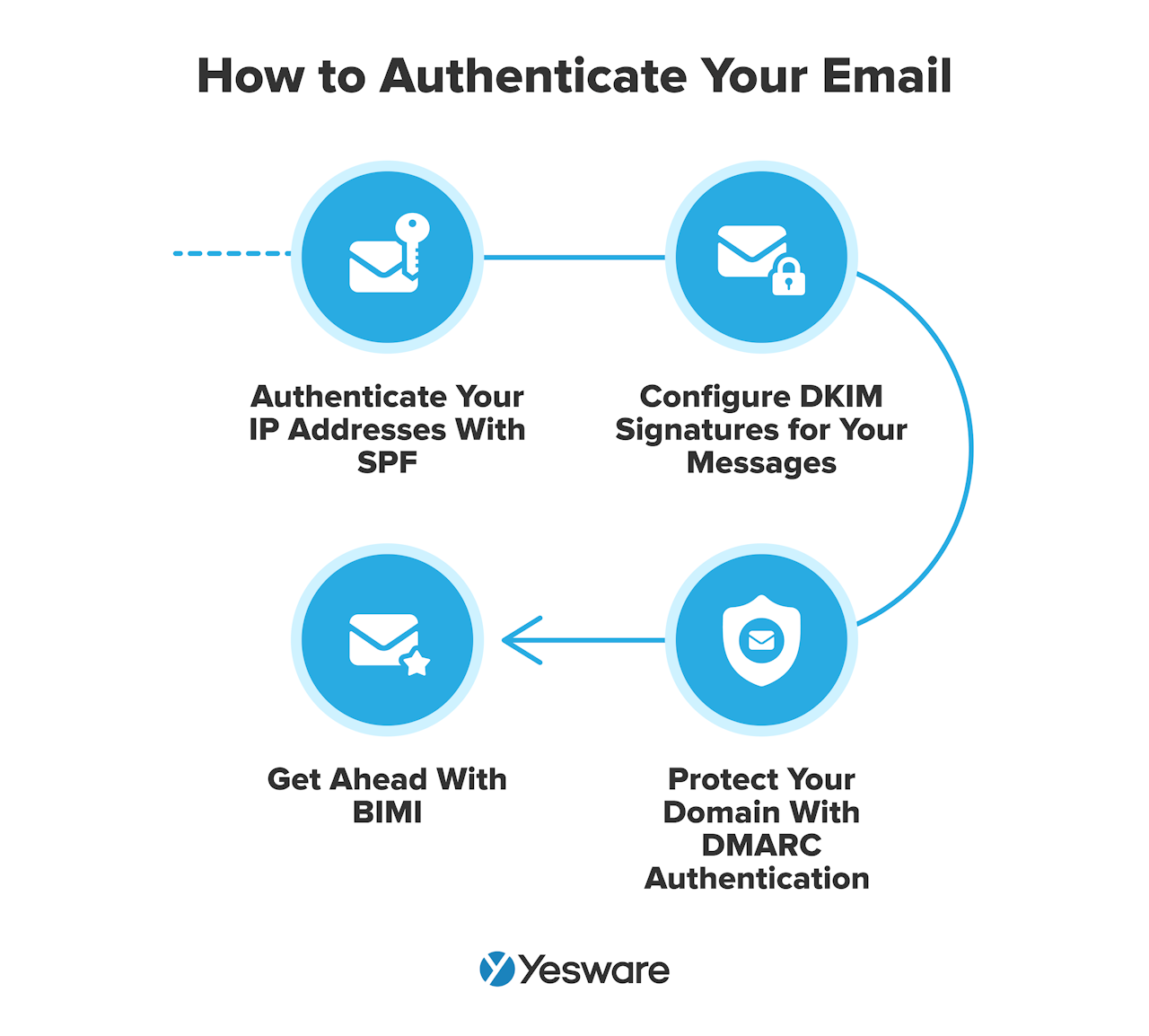 Again, most email automation platforms are designed with these best practices in mind, but do your due diligence when it comes to choosing a provider who can meet your team’s needs.
Again, most email automation platforms are designed with these best practices in mind, but do your due diligence when it comes to choosing a provider who can meet your team’s needs.
Tip: Why Your Emails Are Going to Spam.
Handling Objections and Rejections
Many sales reps also quickly learn that sales objections (and flat-out rejections) are just as common in sales by email as they are over the phone or in person — perhaps even more so.
The screens and keyboards between the two parties make it much easier for recipients to ignore or be critical of your message and overall efforts.
Sales reps should treat email sales objections and rejections just like those they encounter during in-person sales interactions. 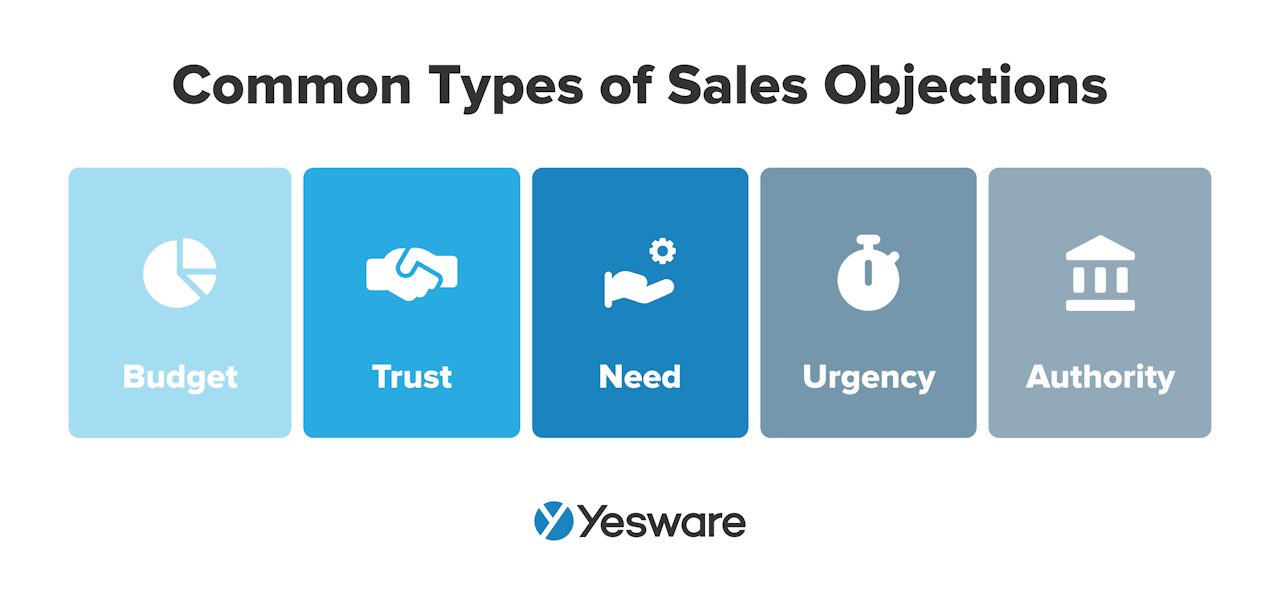 Over time and with regular analysis, sales reps can identify the specific objection responses that are effective in overcoming the most common ones.
Over time and with regular analysis, sales reps can identify the specific objection responses that are effective in overcoming the most common ones.
Staying On Top of Following Up
Most closed-won deals require four or more follow-ups. But fewer than 10% of sales reps actually maintain contact long enough to convert. 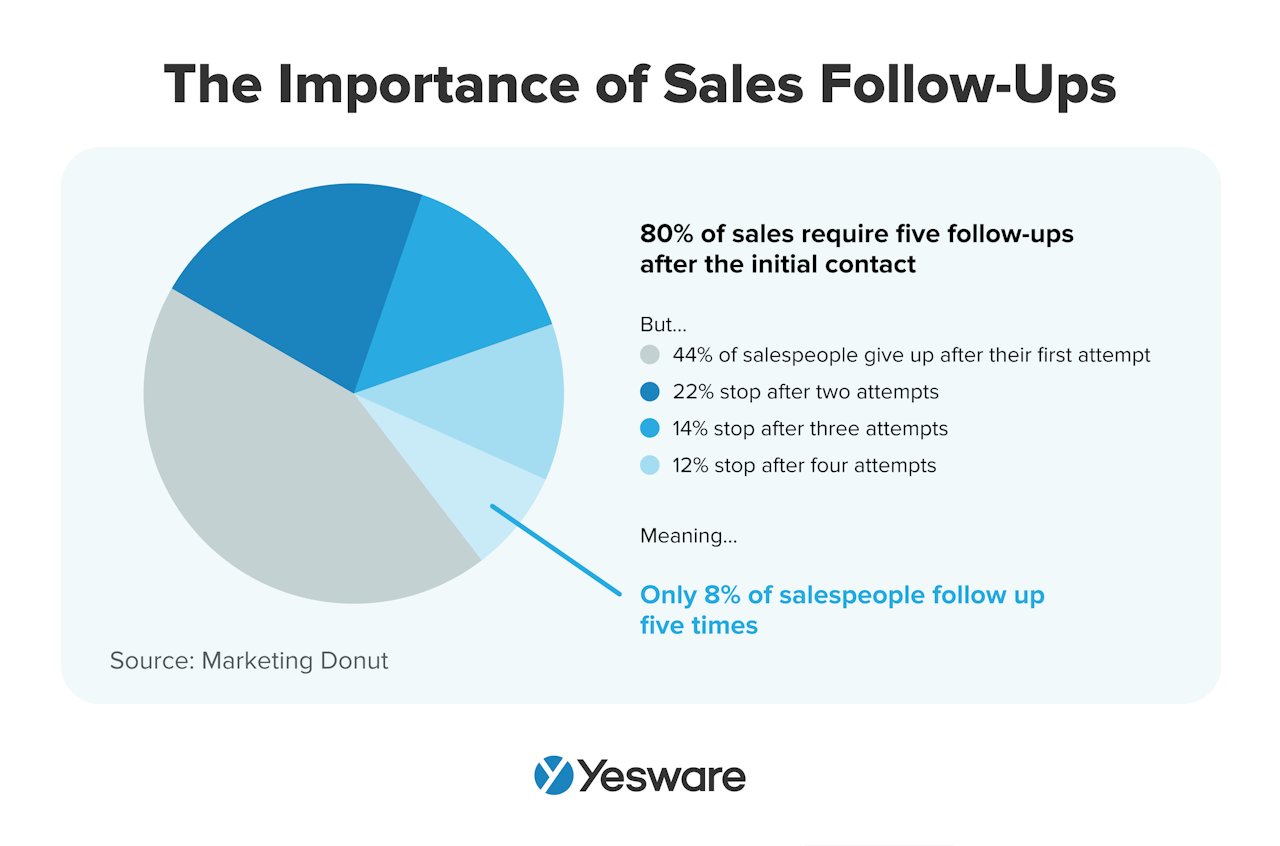 With so many lists to manage and prospects moving through the sales funnel, each at their own pace, it can be incredibly challenging for sales reps to keep track of who needs a follow-up email and when.
With so many lists to manage and prospects moving through the sales funnel, each at their own pace, it can be incredibly challenging for sales reps to keep track of who needs a follow-up email and when.
Fortunately, email automation software can help sales teams juggle the many moving pieces of following up with email recipients.
In fact, sales by email can give sales reps a huge advantage when it comes to following up, as long as they learn how to leverage their tools correctly.
Tip: Looking for ready-to-use email templates for your sales emails? Grab them below.
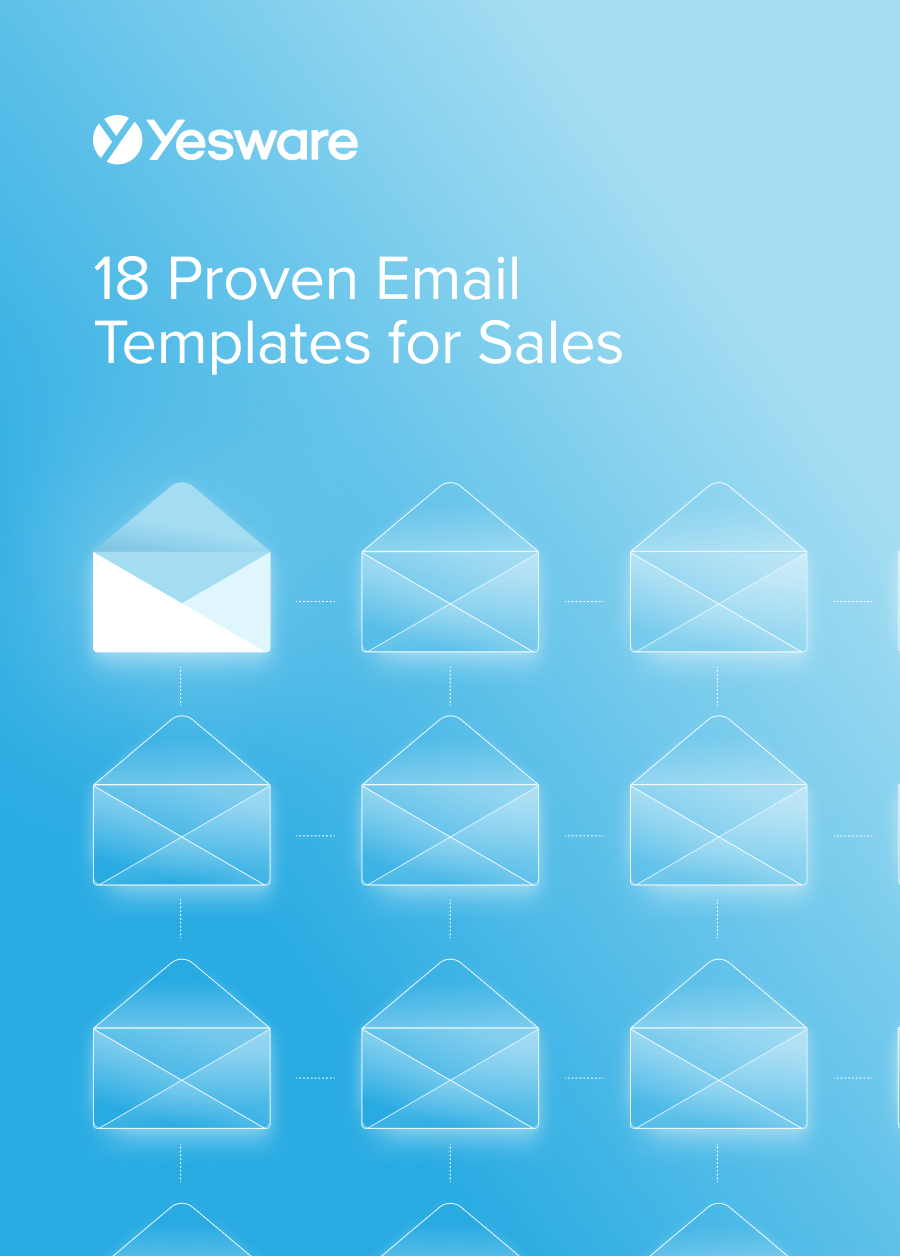 18 Proven Email Templates for SalesWinning email templates for cold outreach, follow-ups, and nurturing relationships – backed by data and real-world examples.
18 Proven Email Templates for SalesWinning email templates for cold outreach, follow-ups, and nurturing relationships – backed by data and real-world examples.
Tips for Optimizing Email Sales Strategies
Here are some of our top tips for creating a successful sales by email strategy: one that builds trusting relationships, nurtures prospects, and creates promising sales opportunities.
A/B Testing
A/B testing is a popular marketing and sales strategy that helps teams determine which of two variables is most effective with their target market. 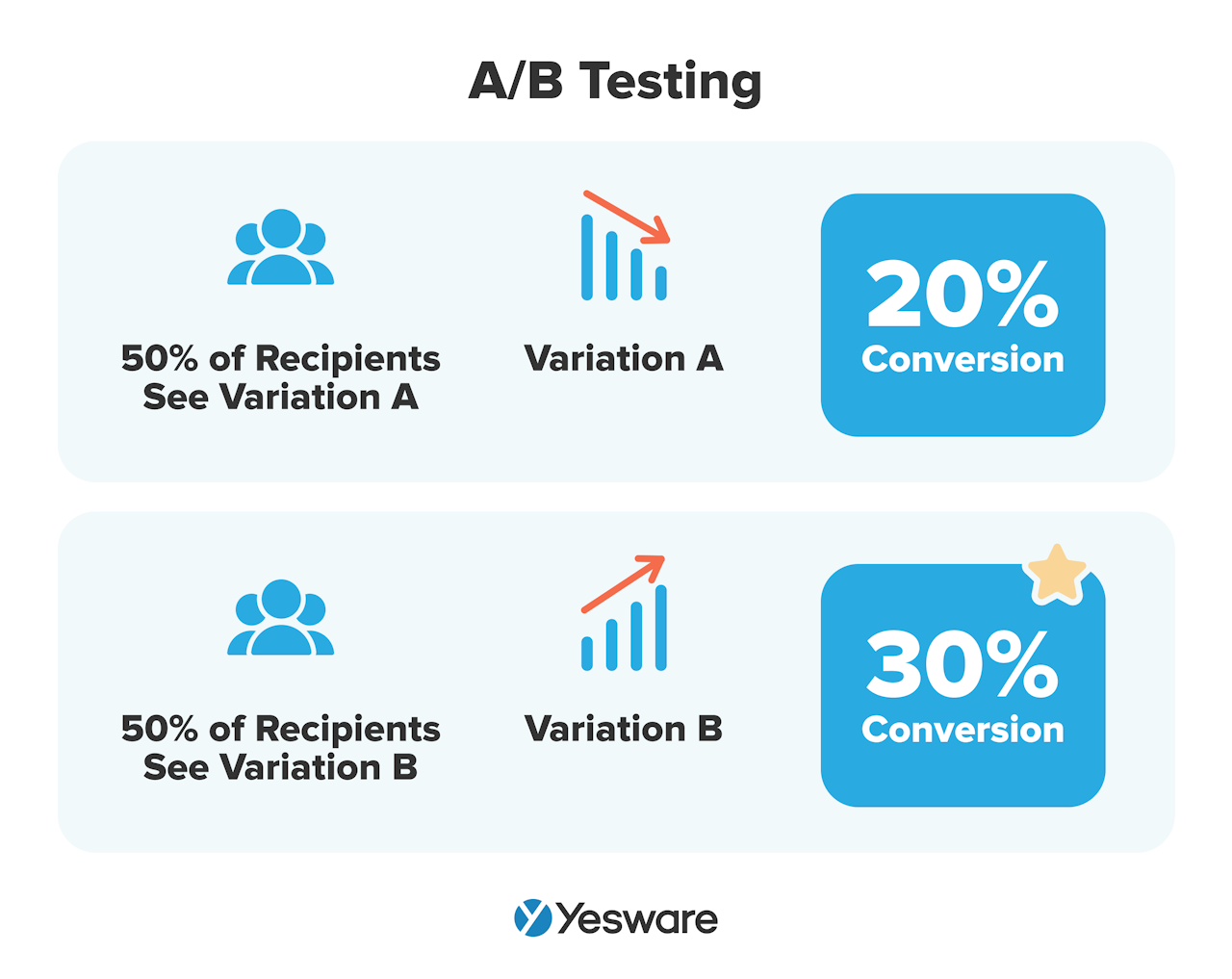 Teams can perform A/B testing to create optimized templates for things like subject lines, email message content, and calls-to-action. In general, a sample size of about 50 – 100 recipients should give you enough data for baseline strategizing.
Teams can perform A/B testing to create optimized templates for things like subject lines, email message content, and calls-to-action. In general, a sample size of about 50 – 100 recipients should give you enough data for baseline strategizing.
Yesware’s Automation
Yesware is an email automation and engagement tool that was built to help sales teams perform personalized email outreach at scale.
Email campaigns will automatically send on their own when prospects don’t respond.
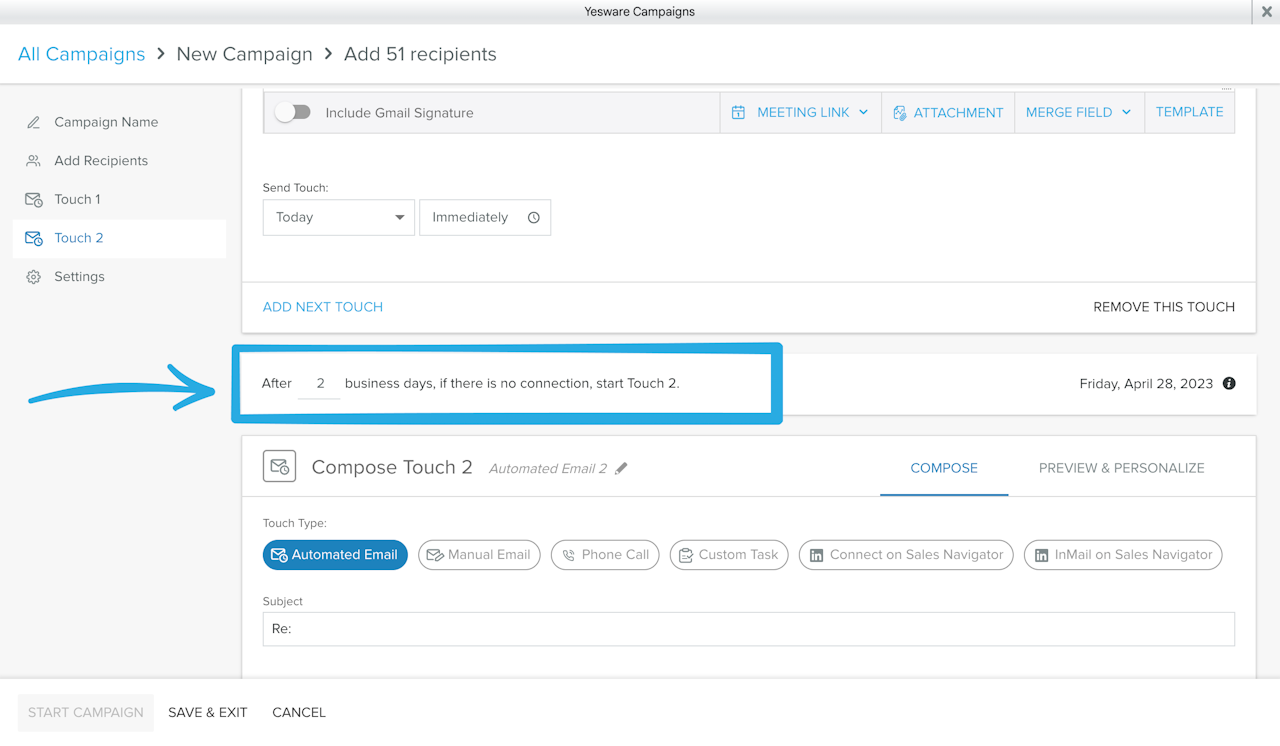
Our suite of tools includes everything from email templates to email tracking.
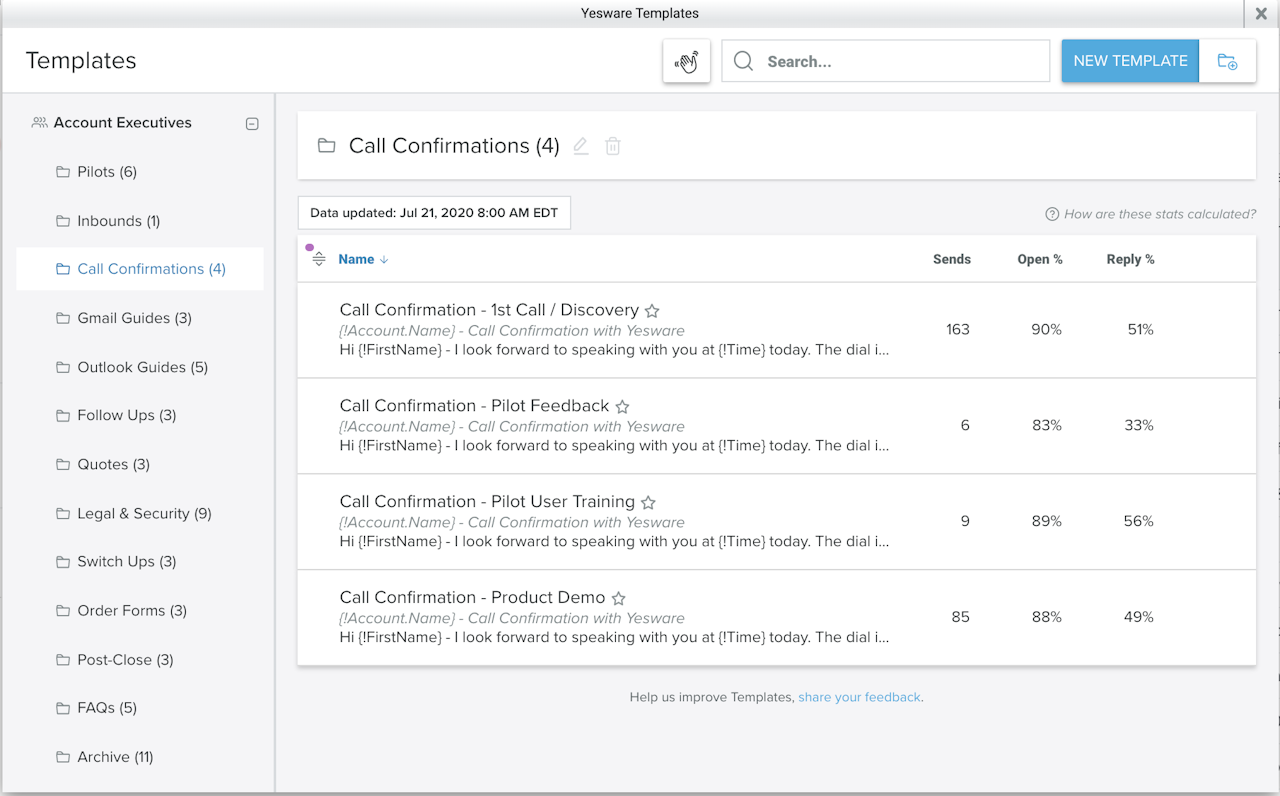
And with tools like Prospector and Contact Enrichment, sales reps will never run out of leads to reach out to. You can source leads in seconds with advanced search filters to find your ICPs.
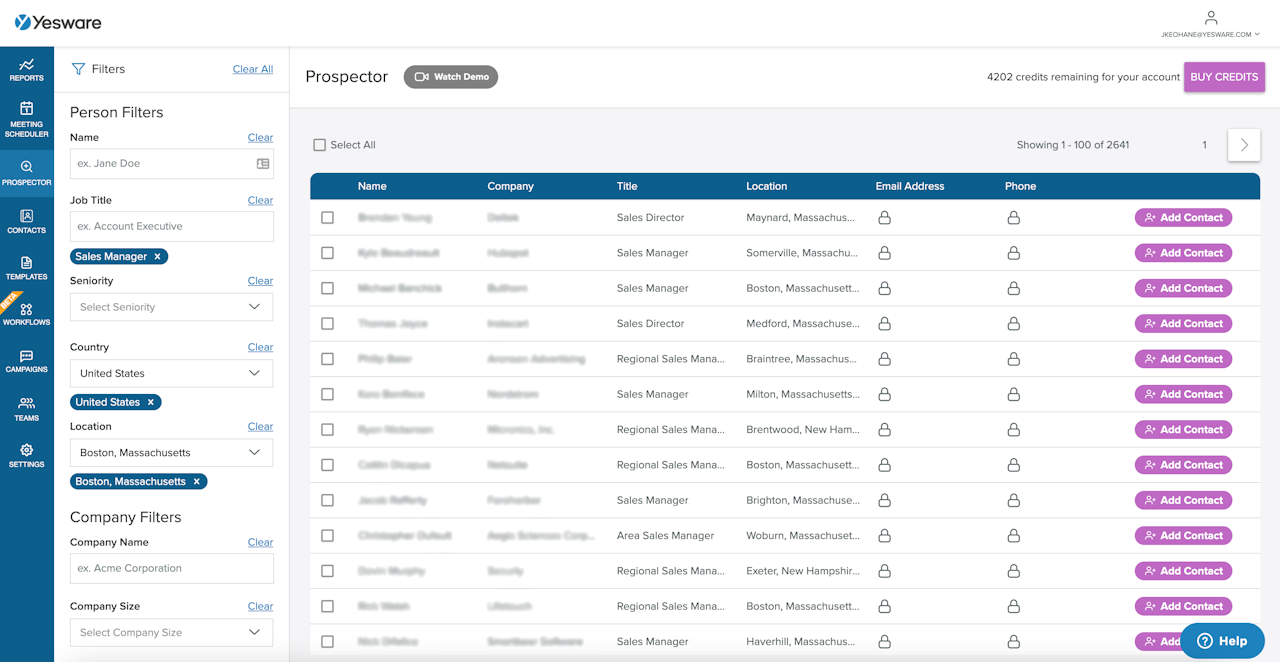
Best of all, all of the tools live directly in your inbox.
With Yesware, sales reps can receive real-time alerts when recipients open their emails and attachments.
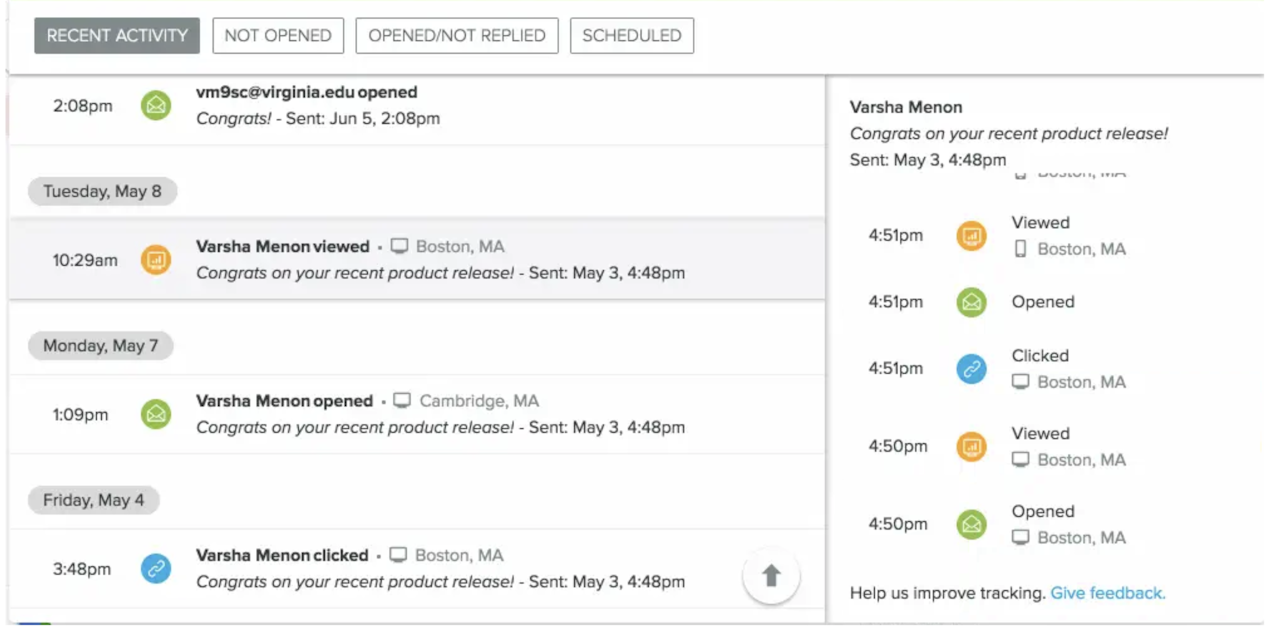
This can give reps a huge advantage when it comes to lead generation and qualifying prospects — research shows that lead contact time can make a huge difference in conversion rates and revenue generation.
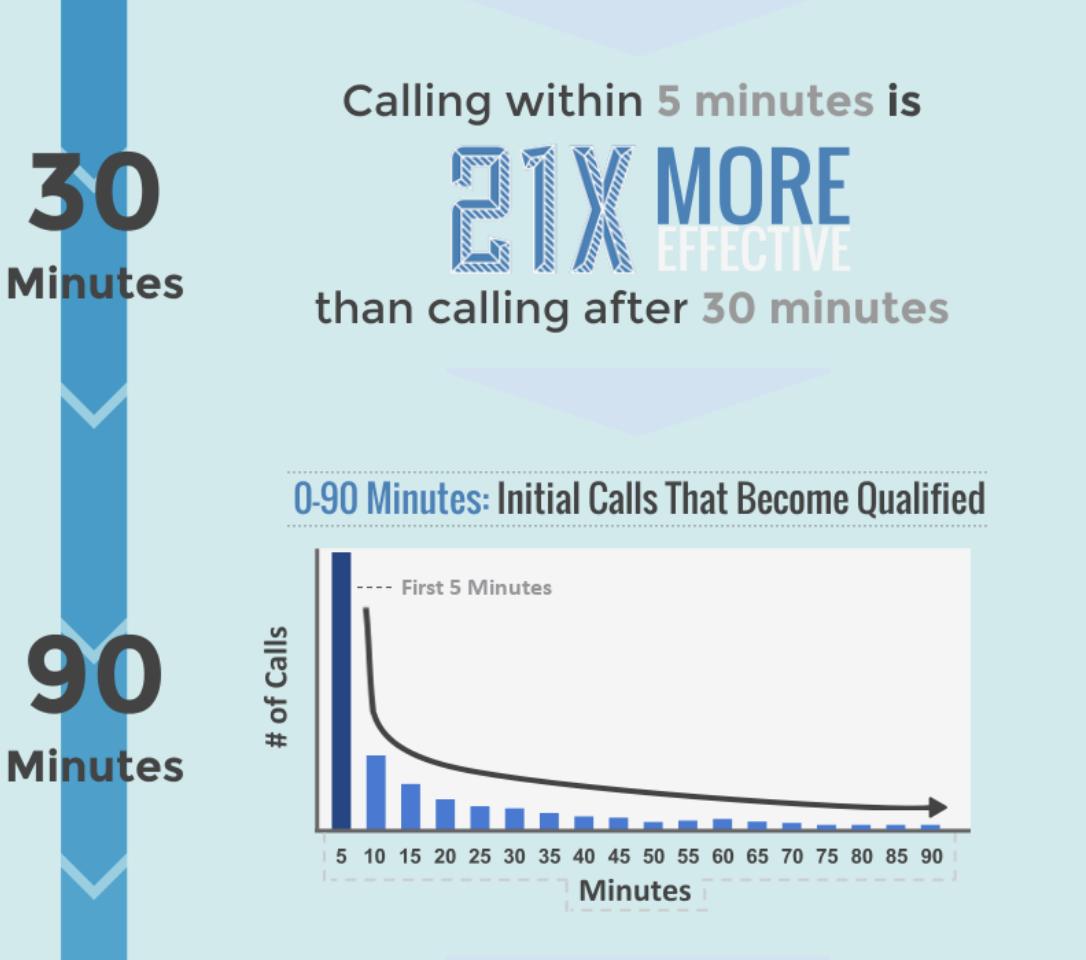
After the initial contact, sales reps can then rely on Yesware to create an automated, personalized follow-up campaign.
From there, Yesware has robust tracking and analytics features that help sales reps keep track of which messages and follow-ups are resonating best with their target market, and which recipients are most engaged with their campaigns.
With ease of use and flexibility in mind, Yesware integrates seamlessly with Gmail, Outlook, and Salesforce (and installs in less than 2 minutes).
Consider Your Timing
Given the sheer number of emails coming and going on a daily basis, smart sales reps look for every advantage they can to stand out from the crowd.
Some hours of the day, for example, generate higher reply rates than others, according to Yesware research.
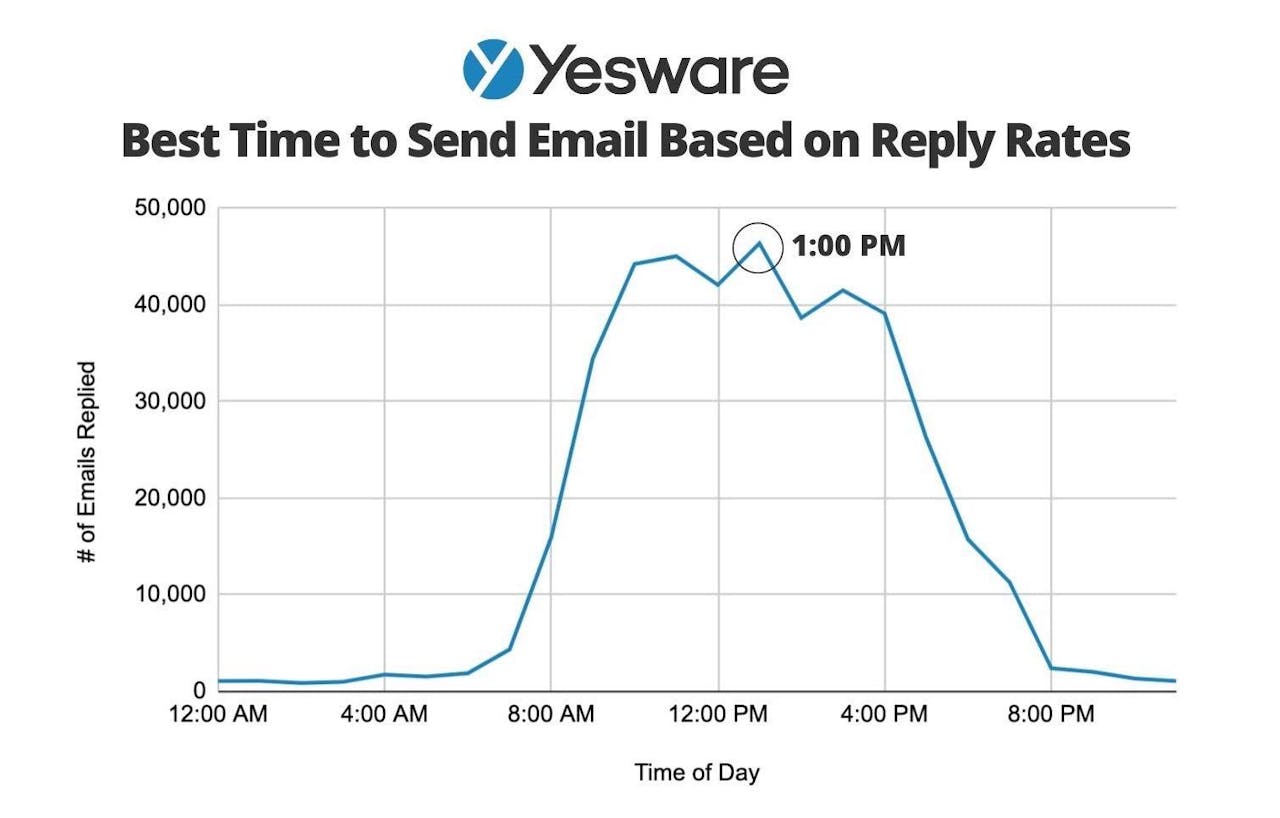
Additionally, Mondays and Tuesdays are more effective than other days of the week.
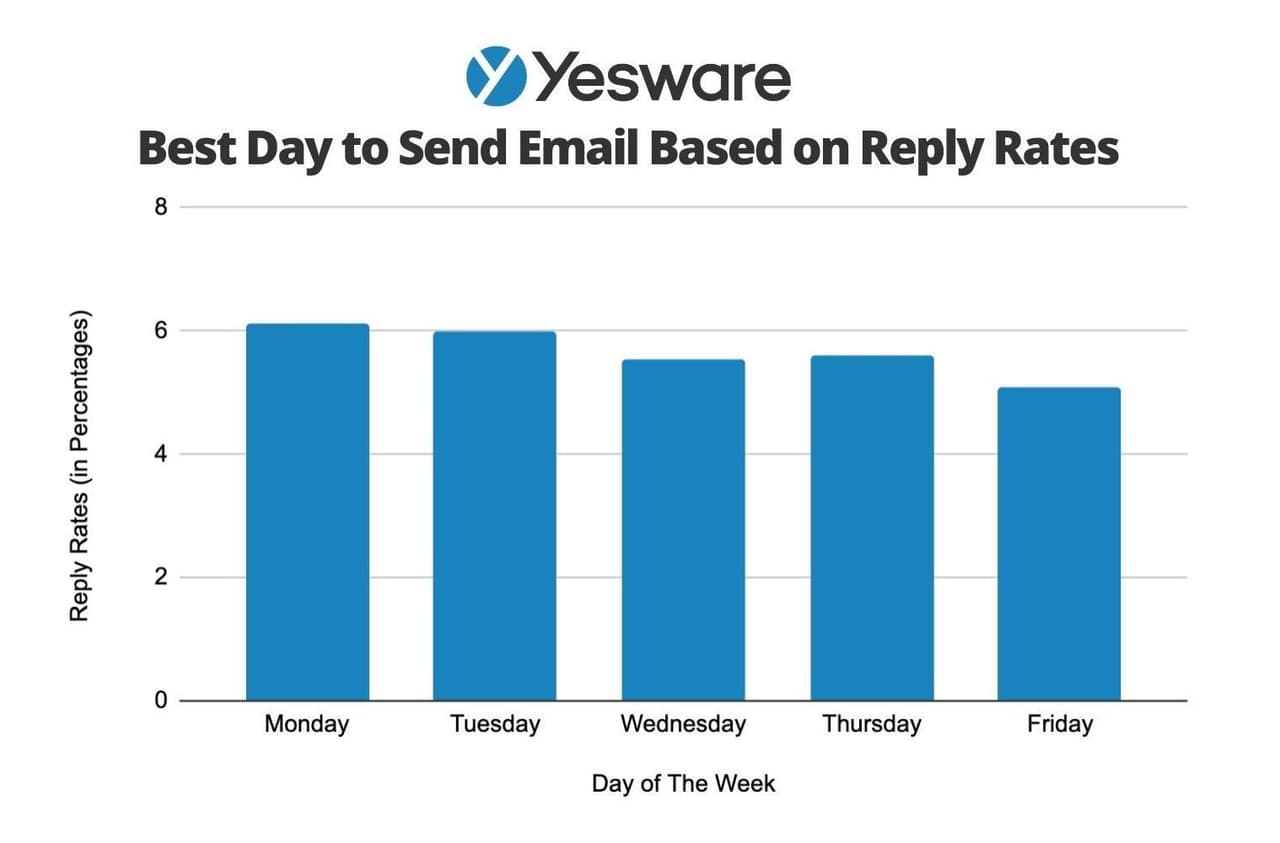
Remember, though, that what matters most is the timing that your target audience prefers. Data from A/B testing can help you determine the best timing for your email outreach.
Learn How to Add Value
Each email message that you send to buyers should offer value in some way. Even follow-up emails should benefit the recipient, even if they’re clear that they’re not ready to purchase.
Remember: sales by email is more like a marathon than a sprint. Each email message should be a small but productive step toward a larger goal.
Follow the Trends
As important as it is for sales teams to understand the nuances of the target market, it’s equally as important for them to stay on top of the market as a whole.
Industry trends and disruptions can have profound impacts on the behavior of your target buyer, so make it a point to stay in the loop about industry happenings.
Compliance and Best Practices
If your team is going to pursue a sales by email strategy, it’s important that everyone who participates is aware of the regulations and best practices required to do it the right way.
Email marketing regulations are rigid and complex, and vary by location.
In the U.S., for example, the CAN-SPAM Act Laws help ensure that marketers don’t take advantage of their access to recipients’ inboxes (among other requirements).
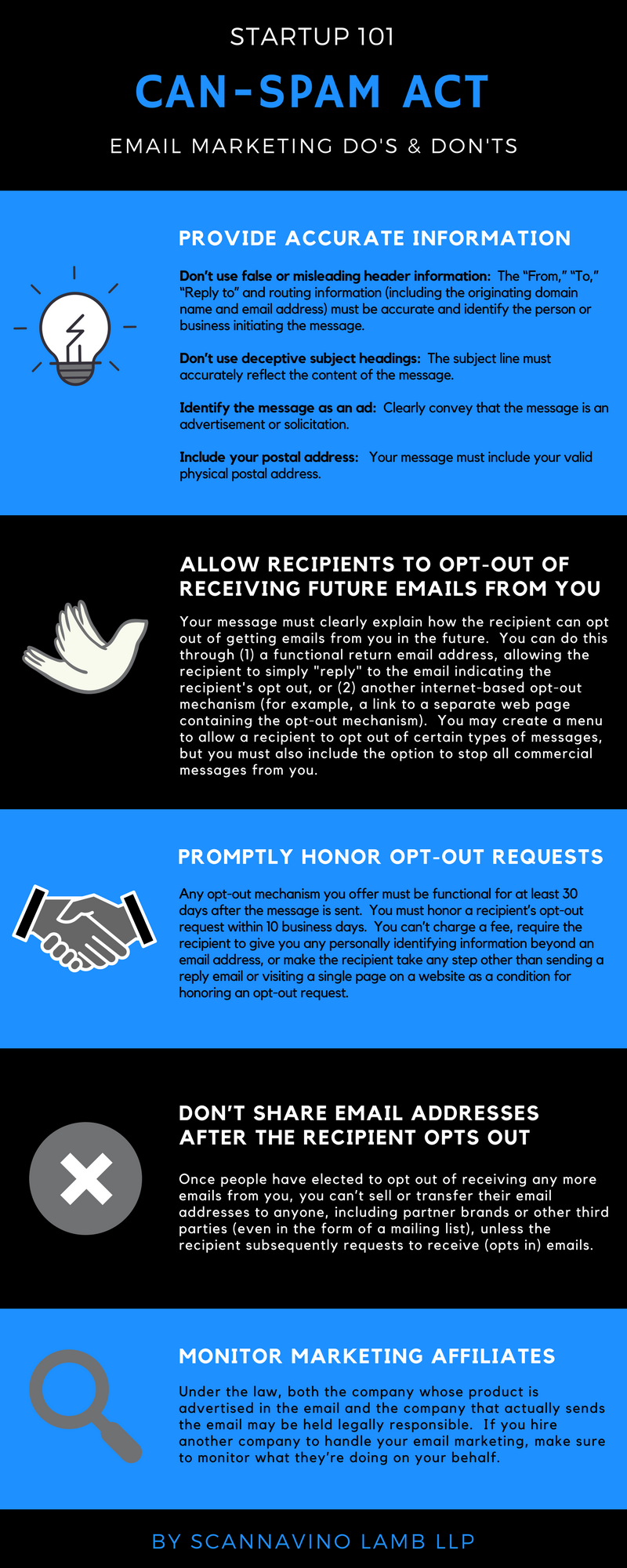
In Canada, similar regulations are called the CASL laws; the European Union also uses its own acronym and set of standards.
Regardless of where your team is based, it’s important that you all understand the laws and regulations around where your recipients live.
It’s also important to make sure your team is upholding a certain standard in the eyes of the recipient, technical standards aside. Don’t use misleading or clickbait subject lines, for example, and always make sure you’re emailing with the intention you advertised when you gathered their email address.
All of your messages should also include clear and easy-to-access “Opt Out” or “Unsubscribe” buttons. Don’t make it difficult for users to stop hearing from you; instead, make your email content so compelling that they have no reason to click unsubscribe.
Key Features to Look for in Email Outreach Solutions
The good news for sales teams is that there are plenty of email outreach platforms to choose from that can accomplish all kinds of impressive and fancy automation tasks.
But be aware when you shop: those bells and whistles can be a double-edged sword, and can even end up doing more harm than good.
In fact, many sales teams who adopt enterprise-level email automation platforms end up abandoning them at some point due to low adoption rates, throwing away time, money, and motivation.
Small businesses need to carefully consider their email outreach solutions and choose one that will help them accelerate — not bog them down with clunky and unnecessarily complex tools.
Cost-Effectiveness
Small businesses often can’t afford to sink a ton of monthly cash into an email outreach solution — especially when they’re not likely to use a lot of what they’d be paying for.
Affordability is an important factor for B2B SMBs. Look carefully at the features offered by the platform versus the cost versus how much of them you’ll actually use. That’s a good starting point in determining how efficiently and effectively a particular tool fits your budget.
It’s also worth noting any additional fees that may come up throughout your contract. Some companies are more transparent with their pricing models than others, so research carefully (and ask questions where anything isn’t clear) to gain a full scope of what you’ll pay for over time.
User-Friendliness
Sales is a fast-paced environment, especially for SMBs that are growing quickly. It’s important that your email outreach solution is intuitive, easy to use, and doesn’t require constant toggling between platforms.
A more streamlined platform leads to higher adoption and overall success rates.
Scalability
Small businesses grow more quickly than at any other stage.
To that end, they need to adopt platforms that can adapt and keep up with the demands of their expansion.
Marketing and sales teams should prioritize email automation features that can accommodate pipelines of different sizes and flexibly grow with them alongside their business.
Conclusion
Sales by email is one of the most effective tools a sales team can master in today’s digital and tech-forward world.
All SMBs should consider adopting an email outreach solution like Yesware that can help their teams reach buyers at scale with custom personalization.
Get started with Yesware for free (access in under 2 minutes).
Get sales tips and strategies delivered straight to your inbox.
Yesware will help you generate more sales right from your inbox. Try our Outlook add-on or Gmail Chrome extension for free, forever!
Related Articles
Jenny Keohane
Jenny Keohane
Melissa Williams
Sales, deal management, and communication tips for your inbox

